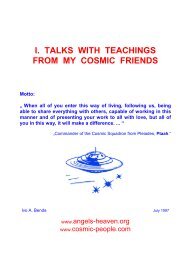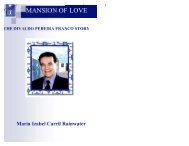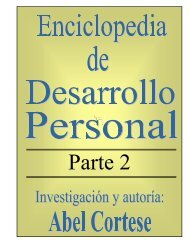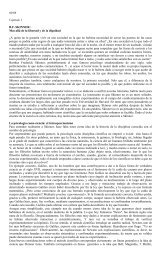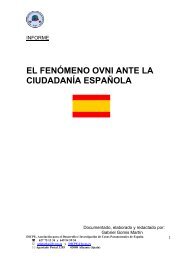The Word That is God
The Word That is God
The Word That is God
Create successful ePaper yourself
Turn your PDF publications into a flip-book with our unique Google optimized e-Paper software.
chants it under control, which directly brings all feeling and all thought in a state of harmony;<br />
brings peace and rest to the soul and puts the mind in a state where it <strong>is</strong> one with <strong>God</strong>.<br />
Science may not be able to explain th<strong>is</strong>, but th<strong>is</strong> <strong>is</strong> a fact which can be verified by experiment.<br />
(Lecture: <strong>The</strong> Kingdom of Heaven)<br />
“Meditate on Om and be a giver of peace to mankind and not an expectant seeker.” (From a<br />
letter written to Mrs. Wellman, a student, on April 3, 1904)<br />
Sri Ramakr<strong>is</strong>hna Paramhansa<br />
On Sunday, December 30, 1883, Sri Ramakr<strong>is</strong>hna asked a monk: “What <strong>is</strong> Brahman?” <strong>The</strong><br />
monk answered: “Brahman <strong>is</strong> Sound. It <strong>is</strong> Om.” Sri Ramakr<strong>is</strong>hna further asked: “But there<br />
must be something indicated by the sound [Om]. Isn’t that so?” To th<strong>is</strong> the monk replied:<br />
“<strong>That</strong> Itself <strong>is</strong> the thing indicated as well as the indicator.” 65 At these words Sri Ramakr<strong>is</strong>hna<br />
went into samadhi. <strong>That</strong> <strong>is</strong>, the immortal truth of the monk’s words lifted H<strong>is</strong> mind into<br />
infinity, thus indicating their truth. (See <strong>The</strong> Gospel of Sri Ramakr<strong>is</strong>hna, p. 372)<br />
“<strong>The</strong> sound Om <strong>is</strong> Brahman. <strong>The</strong> r<strong>is</strong>h<strong>is</strong> and sages pract<strong>is</strong>ed austerity to realize the<br />
Sound-Brahman.<br />
“‘What will you gain’, some sages ask, ‘by merely hearing th<strong>is</strong> sound?’ You hear the roar of<br />
the ocean from a d<strong>is</strong>tance. By following the roar you can reach the ocean. As long as there <strong>is</strong><br />
the roar, there must also be the ocean. By following the trail of Om you attain Brahman, of<br />
which the <strong>Word</strong> <strong>is</strong> the symbol. <strong>That</strong> Brahman has been described by the Vedas as the ultimate<br />
goal.” (<strong>The</strong> Gospel of Sri Ramakr<strong>is</strong>hna, p. 404) 66<br />
“[Anahata] <strong>is</strong> a spontaneous sound constantly going on by Itself. It <strong>is</strong> the sound of the<br />
Pranava, Om. It originates in the Supreme Brahman…. A yogi alone knows that th<strong>is</strong> sound<br />
originates from the Supreme Brahman.” (<strong>The</strong> Gospel of Sri Ramakr<strong>is</strong>hna, p. 416)<br />
“<strong>The</strong> sandhya 67 merges in the Gayatri, the Gayatri in Om, and Om in samadhi. It [Om] <strong>is</strong><br />
like the sound of a bell: t–a–m. <strong>The</strong> yogi, by following in the trail of the sound Om, gradually<br />
merges himself in the Supreme Brahman.” 68 (<strong>The</strong> Gospel of Sri Ramakr<strong>is</strong>hna, p. 465)<br />
By “Gayatri” <strong>is</strong> meant the Savitri Gayatri, the great Vedic mantra for enlightenment. <strong>The</strong><br />
idea expressed here <strong>is</strong> that the other mantras included in the ritual of the sandhya are<br />
eventually dropped and only the simple Gayatri <strong>is</strong> recited. <strong>The</strong>n, in time, the Gayatri itself <strong>is</strong><br />
d<strong>is</strong>continued and only Om <strong>is</strong> repeated. And by the meditation of Om the aspirant “merges<br />
65 <strong>That</strong> <strong>is</strong>, Om <strong>is</strong> both <strong>God</strong> and the Name (Indicator) of <strong>God</strong>.<br />
66 Another translation, by Sachindra Kumar Majumdar, perhaps a bit more on target: “Sound Brahman. R<strong>is</strong>h<strong>is</strong> and sages used<br />
to practice austerities to hear that sound. Upon attaining perfection one hears the sound r<strong>is</strong>ing spontaneously. Some say,<br />
‘What will you gain by hearing the sound only?’ You hear the rumbling from a d<strong>is</strong>tance. If you follow the roar you can reach<br />
the ocean. <strong>The</strong> roar indicates the presence of the ocean. If one follows the trail of the spontaneous sound one can reach what it<br />
indicates. It <strong>is</strong> th<strong>is</strong> which has been called the supreme status.” (5.14.2)<br />
67 Sandhya: A ritual done at the “junctions” (sandhyas) of the day–dawn, noon, and sunset–during which the Savitri Gayatri <strong>is</strong><br />
repeated.<br />
68 Majumdar: “Twilight devotions merge in Gayatri, Gayatri merges in Om, Om merges in samadhi. It <strong>is</strong> like the sound of a<br />
bell, tam, t-a-m. Going beyond the trail of sound the yogi merges in Brahman.” (1.11.2)<br />
77



